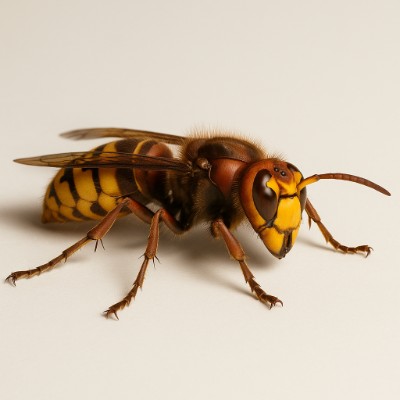
Hornets can be aggressive, and their stings may lead to serious allergic reactions in some individuals. Their nests, often constructed in sheltered areas, can grow rapidly, leading to larger infestations. Here are some key reasons why addressing hornet issues promptly is vital:
- Health Risks: Stings can be dangerous, particularly for those with allergies.
- Property Damage: Nests can cause structural damage to homes and buildings.
- Peace of Mind: Eliminating hornets allows for safer outdoor activities and enjoyment of your property.
Identifying Hornet Nests
Recognizing the signs of a hornet nest is the first step in effective management. These insects typically build their nests in sheltered areas. Here are some characteristics to look for:
| Characteristic | Description |
|---|---|
| Location | Commonly found in trees, shrubs, or under eaves. |
| Appearance | Gray, papery nests that can be round or oval-shaped. |
| Activity | Increased hornet activity around the nest, especially in late summer. |
Safety Tips for Homeowners
If you encounter a hornet nest, it’s important to prioritize safety. Here are some tips to consider:
- Do not attempt to remove the nest without proper protective gear.
- Consider the time of day; hornets are less active in the evening.
- Keep a safe distance and observe the nest before taking action.
Understanding hornet behavior and the importance of timely management can help protect your home and family. Whether you choose to tackle the issue yourself or hire a professional service, being informed is key to effective hornet control in Toronto. In the next section, we will explore various methods for hornet removal and prevention strategies to keep your property safe.
Methods for Removal
When it comes to removing hornets, there are several methods available. Each method has its own advantages and disadvantages, and the choice often depends on the severity of the infestation and the location of the nest. Below are some common methods for removal:
| Method | Description | Pros | Cons |
|---|---|---|---|
| DIY Removal | Using household items or store-bought sprays to eliminate the nest. | Cost-effective; immediate action possible. | Risk of stings; may not be effective for large nests. |
| Professional Extermination | Hiring a pest control service to safely remove the nest. | Expertise in handling hornets; safer for homeowners. | Higher cost; may require scheduling. |
| Traps | Using traps. | Can reduce hornet populations; less invasive. | May not eliminate nests; requires monitoring. |
| Preventive Measures | Implementing strategies to deter them from nesting. | Long-term solution; reduces future infestations. | Requires ongoing effort; may not address existing nests. |
Preventive Strategies
Preventing hornets from nesting on your property is just as important as removal. Here are some effective strategies to deter these pests:
- Seal Entry Points: Inspect your home for gaps and cracks, especially around windows, doors, and eaves, and seal them.
- Remove Food Sources: Keep outdoor trash bins tightly sealed and clean up food spills to avoid attracting them.
- Regular Inspections: Conduct regular checks of your property for signs of hornet activity, especially in late spring and summer.
- Plant Repellent Plants: Consider planting herbs like mint or citronella, which can deter them.
Understanding Hornets and Their Behaviour in Toronto
Hornets are more than a backyard nuisance — they’re a threat to safety, especially during the warmer months in Toronto. With aggressive nesting habits and the potential to cause serious allergic reactions, hornets have become a growing concern for homeowners and businesses alike.
Whether you’ve spotted a hornet nest under your eaves, seen wasps flying around your deck, or are worried about your family’s safety during outdoor activities, this guide is designed to give you expert, practical advice. We’ll also break down services available in Toronto, costs, prevention tips, and how to safely remove them.
Hornets are a type of stinging insect closely related to wasps and yellowjackets. The bald-faced hornet, commonly found in Ontario, is black with white markings and builds large, papery nests. These nests can be found in trees, on homes, in attics, behind siding, under soffits, or even in shrubs and sheds.
Key Characteristics:
-
Aggressive when threatened
-
Can sting multiple times
-
Nests contain hundreds to thousands
-
Most active during spring and summer
-
Often confused with wasps or bees
Hornets are especially dangerous for people who are allergic to their stings. A single sting can result in swelling, pain, and — in extreme cases — life-threatening reactions.
Where Hornets Nest: Common Infestation Sites
Hornets prefer sheltered spaces that are close to food and water sources. In the GTA, nests are frequently found in:
-
Soffits and eaves
-
Behind shutters and siding
-
Under decks or porches
-
Inside sheds, garages, or attic vents
-
In trees or dense bushes
-
Wall voids or outdoor furniture
-
Near garbage bins or compost piles
Identifying the location and size of the nest is the first step in choosing the right removal approach. Attempting to treat a nest without proper tools or protective gear can lead to serious injury.
Signs You Need Hornet Removal Services in Toronto
You may not see the nest immediately, but the presence of hornets is often easy to detect.
Look for:
-
Increased stinging insect activity near your house
-
Hornets entering and exiting a specific area
-
A visible paper-like nest in trees, on the roof, or around the building
-
Buzzing sounds from attic vents or behind walls
-
People or pets getting stung
Once you notice activity, it’s best to contact a licensed hornet exterminator in Toronto before the problem escalates.
Case Study: Commercial Building Nest Removal in North York
Background: Staff at a commercial office building reported multiple stings near the back entrance.
Findings:
-
A paper hornet nest was hidden behind a second-floor soffit.
-
Hornets were entering through a damaged vent cover.
Solution:
-
The building manager hired GTA Toronto Pest Control
-
A telescopic sprayer was used to apply insecticide foam directly into the nest cavity.
-
The vent was later repaired, and follow-up monitoring was done after seven days.
Result:
-
The colony was fully eliminated.
-
Staff reported no further hornet sightings.
-
The company now receives annual inspections as part of a pest management plan.
Hornet Removal Costs
The cost of hornet extermination depends on the size of the nest, location, and whether the property is residential or commercial.
Typical Costs:
-
Small, accessible nest: $175–$300
-
Hard-to-reach nests (e.g., high roofs): $300–$500
-
Severe infestations or multiple nests: $500+
Most companies offer free quotes and guaranteed results for at least 30 days. Some also provide discounts for seniors or repeat customers.
How to Safely Remove Hornets and Related Costs
Safe removal requires the right tools, experience, and knowledge of hornet behaviour.
What Professionals Use:
-
Long-reach sprayers
-
HEPA-rated protective suits
-
Non-toxic insecticides (when possible)
-
Dust or foam applicators
-
Nighttime removal methods (hornets are less active)
While professional services cost more than DIY, they significantly reduce risk and increase success.
Prevention Tips: How to Keep Hornets from Returning
Once a nest is removed, it’s important to take steps to stop them from rebuilding.
Preventative Measures:
-
Seal gaps in siding, soffits, chimneys, and attic vents
-
Remove food sources like fallen fruit, sugary drinks, or open garbage
-
Keep eaves and gutters clean
-
Use essential oil deterrents like peppermint or lemongrass
-
Install fake nests (hornets avoid areas where other colonies are present)
Regular property inspections can help identify early signs of nesting and reduce the need for emergency treatments.
When to Book a Service
Hornets are most active between May and September, but the best time for treatment is early morning or evening when activity is lowest.
Book removal immediately if:
-
Hornets are stinging people or pets
-
The nest is near entrances, decks, or outdoor seating
-
Children or allergic individuals are present
-
You see activity inside vents, walls, or attics
Delaying removal increases the size of the colony, the cost, and the risk of harm.
Hornets vs. Wasps vs. Bees: Know the Difference
| Insect | Colour | Nest Type | Behaviour |
|---|---|---|---|
| Hornet | Black & white | Large papery above ground | Aggressive if provoked |
| Wasp | Black & yellow | Small papery, eaves, walls | More territorial |
| Bee | Fuzzy, brown | Wax hives, inside cavities | Less aggressive |
Hornets and wasps should never be confused with honey bees, which are vital pollinators. Responsible companies will relocate bees instead of exterminating them.
Final Thoughts: Act Early, Stay Safe
Hornets don’t just cause fear — they cause real harm. Don’t wait until someone gets stung or the nest becomes unmanageable.
If you’ve seen increased activity around your home or business, contact GTA Toronto Pest Control to inspect, remove, and help you prevent future nests.
With the right support, expert help, and proven techniques, you can safely eliminate hornets — and take back your yard.
Author Bio: Naeem Choudhry
Pest Control Expert
Naeem Choudhry is a seasoned pest control specialist with over 20 years of hands-on experience. Based in Toronto, he stays up to date with the latest industry best practices and is an active member of the National Pest Management Association of Canada.
Known for his practical tips and outstanding customer service, Naeem frequently hosts community workshops where he educates the public on pest identification, behaviour, and effective control methods. When he’s not out in the field, he shares his expertise through articles, educational events, and community outreach initiatives.
For more insights, follow him on x.com.
